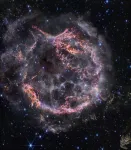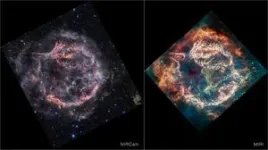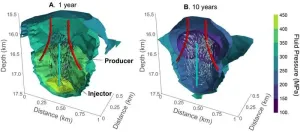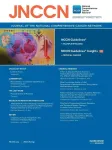(Press-News.org) Like a shiny, round ornament ready to be placed in the perfect spot on a holiday tree, supernova remnant Cassiopeia A (Cas A) gleams in a new image from NASA’s James Webb Space Telescope. As part of the 2023 Holidays at the White House, First Lady of the United States Dr. Jill Biden debuted the first-ever White House Advent Calendar. To showcase the “Magic, Wonder, and Joy” of the holiday season, Dr. Biden and NASA are celebrating with this new image from Webb.
While all is bright, this scene is no proverbial silent night. Webb’s NIRCam (Near-Infrared Camera) view of Cas A displays this stellar explosion at a resolution previously unreachable at these wavelengths. This high-resolution look unveils intricate details of the expanding shell of material slamming into the gas shed by the star before it exploded.
Cas A is one of the most well-studied supernova remnants in all of the cosmos. Over the years, ground-based and space-based observatories, including NASA’s Chandra X-Ray Observatory, Hubble Space Telescope, and retired Spitzer Space Telescope have assembled a multiwavelength picture of the object’s remnant.
However, astronomers have now entered a new era in the study of Cas A. In April 2023, Webb’s MIRI (Mid-Infrared Instrument) started this chapter, revealing new and unexpected features within the inner shell of the supernova remnant. Many of those features are invisible in the new NIRCam image, and astronomers are investigating why.
‘Like Shards of Glass’
Infrared light is invisible to our eyes, so image processors and scientists translate these wavelengths of light to visible colors. In this newest image of Cas A, colors were assigned to different filters from NIRCam, and each of those colors hints at different activity occurring within the object.
At first glance, the NIRCam image may appear less colorful than the MIRI image. However, this simply comes down to the wavelengths in which the material from the object is emitting its light.
The most noticeable colors in Webb’s newest image are clumps represented in bright orange and light pink that make up the inner shell of the supernova remnant. Webb’s razor-sharp view can detect the tiniest knots of gas, comprised of sulfur, oxygen, argon, and neon from the star itself. Embedded in this gas is a mixture of dust and molecules, which will eventually become components of new stars and planetary systems. Some filaments of debris are too tiny to be resolved by even Webb, meaning they are comparable to or less than 10 billion miles across (around 100 astronomical units). In comparison, the entirety of Cas A spans 10 light-years across, or 60 trillion miles.
“With NIRCam’s resolution, we can now see how the dying star absolutely shattered when it exploded, leaving filaments akin to tiny shards of glass behind,” said Danny Milisavljevic of Purdue University, who leads the research team. “It’s really unbelievable after all these years studying Cas A to now resolve those details, which are providing us with transformational insight into how this star exploded.”
Hidden Green Monster
When comparing Webb’s new near-infrared view of Cas A with the mid-infrared view, its inner cavity and outermost shell are curiously devoid of color.
The outskirts of the main inner shell, which appeared as a deep orange and red in the MIRI image, now look like smoke from a campfire. This marks where the supernova blast wave is ramming into surrounding circumstellar material. The dust in the circumstellar material is too cool to be detected directly at near-infrared wavelengths, but lights up in the mid-infrared.
Researchers say the white color is light from synchrotron radiation, which is emitted across the electromagnetic spectrum, including the near-infrared. It’s generated by charged particles traveling at extremely high speeds spiraling around magnetic field lines. Synchrotron radiation is also visible in the bubble-like shells in the lower half of the inner cavity.
Also not seen in the near-infrared view is the loop of green light in the central cavity of Cas A that glowed in mid-infrared, nicknamed the Green Monster by the research team. This feature was described as “challenging to understand” by researchers at the time of their first look.
While the ‘green’ of the Green Monster is not visible in NIRCam, what’s left over in the near-infrared in that region can provide insight into the mysterious feature. The circular holes visible in the MIRI image are faintly outlined in white and purple emission in the NIRCam image – this represents ionized gas. Researchers believe this is due to the supernova debris pushing through and sculpting gas left behind by the star before it exploded.
Baby Cas A
Researchers were also absolutely stunned by one fascinating feature at the bottom right corner of NIRCam’s field of view. They’re calling that large, striated blob Baby Cas A – because it appears like an offspring of the main supernova.
This is a light echo, where light from the star’s long-ago explosion has reached and is warming distant dust, which is glowing as it cools down. The intricacy of the dust pattern, and Baby Cas A’s apparent proximity to Cas A itself, are particularly intriguing to researchers. In actuality, Baby Cas A is located about 170 light-years behind the supernova remnant.
There are also several other, smaller light echoes scattered throughout Webb’s new portrait.
The Cas A supernova remnant is located 11,000 light-years away in the constellation Cassiopeia. It’s estimated to have exploded about 340 years ago from our point of view.
The James Webb Space Telescope is the world’s premier space science observatory. Webb is solving mysteries in our solar system, looking beyond to distant worlds around other stars, and probing the mysterious structures and origins of our universe and our place in it. Webb is an international program led by NASA with its partners, ESA (European Space Agency) and the Canadian Space Agency.
END
NASA’s Webb stuns with new high-definition look at exploded star
2023-12-11
ELSE PRESS RELEASES FROM THIS DATE:
NASA’s MAVEN observes the disappearing solar wind
2023-12-11
In December 2022, NASA’s MAVEN (Mars Atmosphere and Volatile EvolutioN) mission observed the dramatic and unexpected “disappearance” of a stream of charged particles constantly emanating off the Sun, known as the solar wind. This was caused by a special type of solar event that was so powerful, it created a void in its wake as it traveled through the solar system.
Due to this event, MAVEN’s measurements at Mars showed that the number of particles making up the solar wind dropped significantly. Without the pressure of the solar wind, the Martian atmosphere and magnetosphere expanded by thousands of kilometers. MAVEN is the only asset currently at Mars able to ...
Don't say "vegan"
2023-12-11
As presented at the Society for Risk Analysis 2023 Annual conference, Patrycja Sleboda from Baruch College – CUNY and her colleagues from the University of Southern California conducted a national food choice experiment to determine how people respond to labels such as “vegan” and “plant-based” compared to “healthy,” “sustainable,” or “healthy and sustainable.”
Research has shown that limiting meat and dairy intake and eating more fruit and vegetables reduces the risk of cardiovascular diseases, Type 2 diabetes, and cancer. Diets with less meat and dairy are also more environmentally ...
Group summarizes guidance for the prevention, diagnosis, evaluation, and treatment of hepatitis C virus in chronic kidney disease
2023-12-11
Embargoed for release until 5:00 p.m. ET on Monday 11 December 2023
Annals of Internal Medicine Tip Sheet
@Annalsofim
Below please find summaries of new articles that will be published in the next issue of Annals of Internal Medicine. The summaries are not intended to substitute for the full articles as a source of information. This information is under strict embargo and by taking it into possession, media representatives are committing to the terms of the embargo not only on their own behalf, but also on behalf of the organization they represent.
----------------------------
1. Group summarizes guidance for the prevention, ...
Conference indicates surging interest in superhot, superdeep geothermal energy
2023-12-11
Conference indicates surging interest in superhot, superdeep geothermal energy
--Renewable resource has potential to revolutionize our energy system
For Immediate Release: December 11, 2023
By Elizabeth A. Thomson for Quaise Energy
For more information, including technical papers and graphic, please contact Elizabeth Thomson, 22elizabeththomson@gmail.com.
CAMBRIDGE, Mass.--In an indication of growing interest in the holy grail of geothermal energy—tapping ...
UM School of Medicine awarded nearly $30 Million to improve health outcomes of IV drug users
2023-12-11
University of Maryland School of Medicine (UMSOM) Dean Mark T. Gladwin, MD, announced today that the school will receive a $29 million research award over four years from the National Institutes of Health to lead a multicenter trial that aims to improve health outcomes in people who inject opioid drugs and are hospitalized with infectious complications of their drug use. Faculty affiliated with the Institute of Human Virology and the Kahlert Institute for Addiction Medicine at UMSOM will be conducting the research.
The research award, which has provided ...
Risk factors for long-term arm morbidities following breast cancer treatments: A systematic review
2023-12-11
“This review revealed 29 primary risk factors associated with arm morbidity after breast cancer treatment.”
BUFFALO, NY- December 11, 2023 – A new review paper was published in Oncotarget's Volume 14 on December 1, 2023, entitled, “Risk factors for long-term arm morbidities following breast cancer treatments: A systematic review.”
In this review, researchers Ifat Klein, Michael Friger, Merav Ben David, and Danit Shahar from Assuta Medical Center and Ben-Gurion University of the Negev in Israel ...
Clues to preventing Alzheimer’s come from patient who, despite genetics, evaded disease
2023-12-11
Alzheimer’s disease has plagued one large Colombian family for generations, striking down half of its members in the prime of life. But one member of that family evaded what had seemed would be fate: Despite inheriting the genetic defect that caused her relatives to develop dementia in their 40s, she stayed cognitively healthy into her 70s.
Researchers at Washington University School of Medicine in St. Louis now think they know why. A previous study had reported that, unlike her relatives, the woman carried ...
Hungarian scientists prove that senescence can accelerate evolution
2023-12-11
The mystery of aging has fascinated people for millennia, with many willing to do anything to halt or reverse this process, because aging is typically associated with gradual deterioration of most body functions. While senescence is a natural part of life, biologists understand surprisingly little about the emergence of this process during evolution. It is not clear whether aging is inevitable, because there are organisms that seemingly do not age at all, moreover, the phenomenon known as negative aging, or rejuvenation, does exist: some turtles’ vital functions improve ...
Real world data shows impact of immunotherapy in populations underrepresented in clinical trials, according to JNCCN study
2023-12-11
PLYMOUTH MEETING, PA [December 11, 2023] — New research in the December 2023 issue of JNCCN—Journal of the National Comprehensive Cancer Network finds patients treated with first-line immunotherapy for advanced Non-Small Cell Lung Cancer (NSCLC) showed similar results in terms of survival, progression-free survival, and treatment duration, regardless of race or ethnicity, even with differences in income and insurance. The clinical investigators focused on patients in under-represented groups who were typically less likely to be included in the immunotherapy clinical trials that have been conducted ...
Research by Sylvester, collaborators leads to new treatment options for advanced myelofibrosis, other blood malignancies
2023-12-11
DOWNLOADABLE VIDEO
MIAMI, FLORIDA (EMBARGOED UNTIL MONDAY, DEC. 11, 2023, AT 2:45 P.M. ET) – Few standard treatments have been available for advanced myelofibrosis, a bone marrow disorder characterized by excessive scar tissue that disrupts the normal production of blood cells
But new research conducted by investigators at Sylvester Comprehensive Cancer Center at the University of Miami Miller School of Medicine and collaborating cancer centers indicates that a new type of targeted therapy may ...







